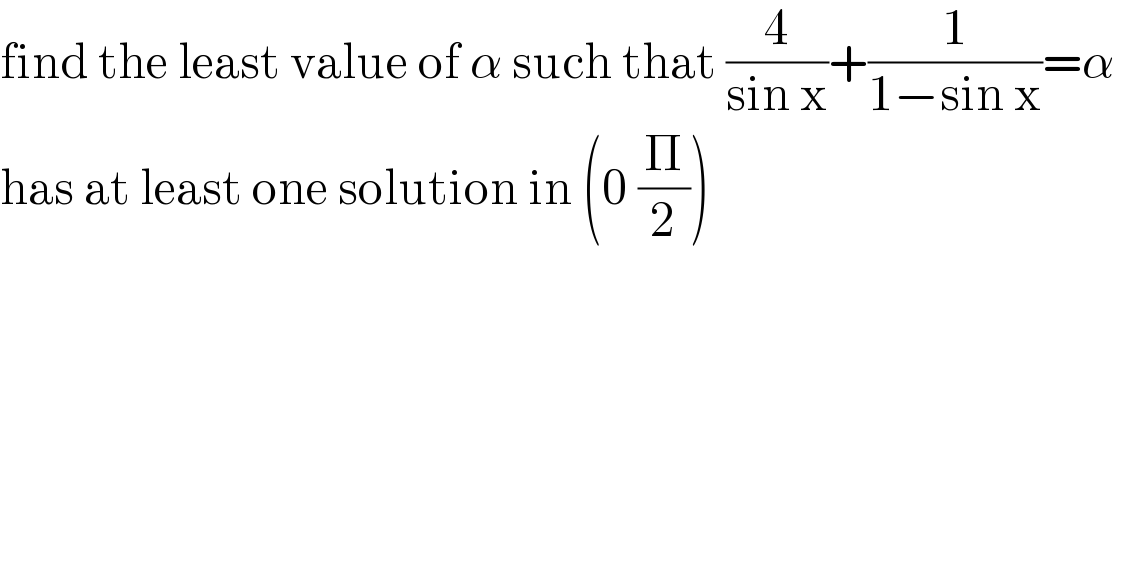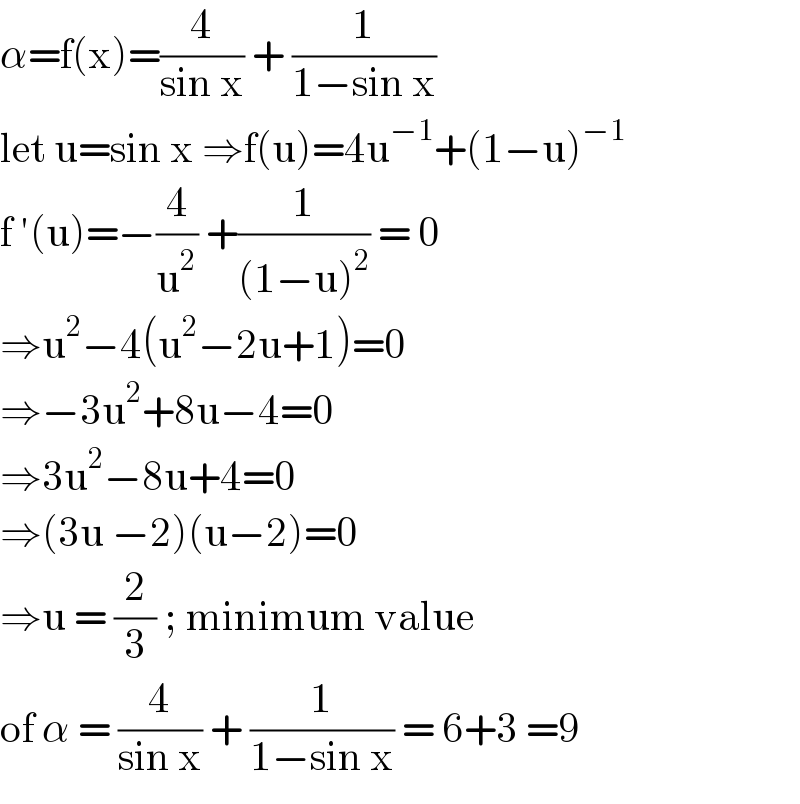Question Number 144833 by gsk2684 last updated on 29/Jun/21

$$\mathrm{find}\:\mathrm{the}\:\mathrm{least}\:\mathrm{value}\:\mathrm{of}\:\alpha\:\mathrm{such}\:\mathrm{that}\:\frac{\mathrm{4}}{\mathrm{sin}\:\mathrm{x}}+\frac{\mathrm{1}}{\mathrm{1}−\mathrm{sin}\:\mathrm{x}}=\alpha\: \\ $$$$\mathrm{has}\:\mathrm{at}\:\mathrm{least}\:\mathrm{one}\:\mathrm{solution}\:\mathrm{in}\:\left(\mathrm{0}\:\frac{\Pi}{\mathrm{2}}\right) \\ $$
Answered by liberty last updated on 29/Jun/21

$$\alpha=\mathrm{f}\left(\mathrm{x}\right)=\frac{\mathrm{4}}{\mathrm{sin}\:\mathrm{x}}\:+\:\frac{\mathrm{1}}{\mathrm{1}−\mathrm{sin}\:\mathrm{x}} \\ $$$$\mathrm{let}\:\mathrm{u}=\mathrm{sin}\:\mathrm{x}\:\Rightarrow\mathrm{f}\left(\mathrm{u}\right)=\mathrm{4u}^{−\mathrm{1}} +\left(\mathrm{1}−\mathrm{u}\right)^{−\mathrm{1}} \\ $$$$\mathrm{f}\:'\left(\mathrm{u}\right)=−\frac{\mathrm{4}}{\mathrm{u}^{\mathrm{2}} }\:+\frac{\mathrm{1}}{\left(\mathrm{1}−\mathrm{u}\right)^{\mathrm{2}} }\:=\:\mathrm{0} \\ $$$$\Rightarrow\mathrm{u}^{\mathrm{2}} −\mathrm{4}\left(\mathrm{u}^{\mathrm{2}} −\mathrm{2u}+\mathrm{1}\right)=\mathrm{0} \\ $$$$\Rightarrow−\mathrm{3u}^{\mathrm{2}} +\mathrm{8u}−\mathrm{4}=\mathrm{0} \\ $$$$\Rightarrow\mathrm{3u}^{\mathrm{2}} −\mathrm{8u}+\mathrm{4}=\mathrm{0} \\ $$$$\Rightarrow\left(\mathrm{3u}\:−\mathrm{2}\right)\left(\mathrm{u}−\mathrm{2}\right)=\mathrm{0} \\ $$$$\Rightarrow\mathrm{u}\:=\:\frac{\mathrm{2}}{\mathrm{3}}\:;\:\mathrm{minimum}\:\mathrm{value} \\ $$$$\mathrm{of}\:\alpha\:=\:\frac{\mathrm{4}}{\mathrm{sin}\:\mathrm{x}}\:+\:\frac{\mathrm{1}}{\mathrm{1}−\mathrm{sin}\:\mathrm{x}}\:=\:\mathrm{6}+\mathrm{3}\:=\mathrm{9} \\ $$
Commented by gsk2684 last updated on 29/Jun/21

$$\mathrm{thank}\:\mathrm{you}\: \\ $$$$\mathrm{kindly}\:\mathrm{explain}\:\mathrm{why}\:\mathrm{did}\:\mathrm{not}\: \\ $$$$\mathrm{find}\:\mathrm{second}\:\mathrm{derivative}\:\mathrm{for}\:\mathrm{verifying}\: \\ $$$$\mathrm{whether}\:\mathrm{it}\:\mathrm{is}\:\mathrm{positive}\:\mathrm{or}\:\mathrm{negative}? \\ $$
Commented by liberty last updated on 30/Jun/21

$$\mathrm{i}\:\mathrm{used}\:\mathrm{first}\:\mathrm{test}\:\mathrm{derivative}\: \\ $$
